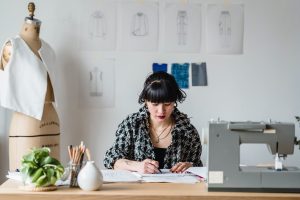Tripod Brixton,
Lambeth Town Hall,
1 Brixton Hill, London,
SW2 1RW
Hours: Monday to Friday, 8am – 7pm
Phone: 020 7580 7333

Stylists have the ability to curate outfits for various purposes in the fashion and entertainment industry or organise clothing and products to be photographed. There are lots of different types of Stylists within this category, for example wardrobe stylists on films, fashion stylists on photoshoots and personal stylists for individuals.
The way the product is placed, folded, fitted to a mannequin or pinned to a board and the way a model is fitted and styled in clothing or accessories. Stylists create outfits by researching, sketching and creating mood boards to communicate suggested colours, textures and styles. They then source the outfit, from either the production wardrobe provided or by finding pieces in the high-street stores. On set, stylists adjust and maintain outfits throughout the production. It is important to understand the producer and director’s vision for a shoot and how that can interpret in clothes and accessories.
What are some of their responsibilities?
• Planning outfits – talking to the director and understanding their vision, researching, sketching and piecing outfits together
• Sourcing outfits – from scratch, wardrobes or from the high-street (depending on the production)
• Styling models or products – this may include models or products for tv, film, commercials, ecommerce or editorial
• Understanding of sewing and being able to make basic adjustments on set
• Maintaining outfits on shoots – making sure that they fit right or have the correct adjustments made
• Overseeing cleaning or repairs post shoot
Who do Stylists work alongside?
• Production Designer
• Art Director
• Producer
• Director
• Hair and Makeup Stylist
What makes a great Stylist?
A great stylist knows the latest trends and can sense future trends in the industry. Something worth knowing is the Editing process, usually Premiere Pro on a video production and photoshop on a photoshoot – although you may not need to use it, it helps to know how things work to understand how the end result should look. It is also helpful to have a basic understanding of pinning and folding clothing, it may not be required as much if you are working with models but it is handy to have the knowledge.
Sewing is a great skill to have as it enables you to make adjustments on set.
How to become a Stylist?
It is not essential to have a degree to become a Stylist. However, it can provide you with a background in the industry and help you develop a network of contacts – you can study Fashion (https://www.ravensbourne.ac.uk/study/undergraduate/ba-hons-fashion) or specifically fashion styling (https://www.dmu.ac.uk/study/courses/undergraduate-courses/fashion-communication-and-styling-ba-degree/fashion-communication-and-styling-ba-degree.aspx) at a variety of different universities – it’s worth doing your research!
Networking
There are different ways to network –
• Attending events is a fantastic way to meet people in person
• LinkedIn – make connections!
• Facebook Pages – join a group and they will post jobs and advice!
• Talk to previous clients about extra work – sell yourself!
Work Experience
• Different set designers may offer work experience opportunities to build up your CV, enquire with them to see if they offer anything that may help!
• You could start as a stylist’s assistant, production assistant or runner in commercial, eCommerce, film or TV and work your way up – make sure to ask questions!
Courses
• Among other courses London College of Style offers an intensive 12-week programme covering e-commerce, styling for magazines, art direction and styling for TV and celebrities. This course has excellent industry connections and the fees include a professional industry styling kit of a portable steamer, pins, clips, tape, sewing kit, shoehorn and other materials (https://londoncollegeofstyle.com/courses/foundation-in-fashion-personal-styling-diploma/)
• For an introduction to styling and fashion photography, Conde Nast offer a beginners 8-week course. This course explores how to create, conceptualise, set up and successfully complete a shoot. Students will learn how to recognise key influencers in fashion styling and photography, and how styling is used in different areas of the industry, including editorial, still life, advertising, streetstyle, and celebrity styling. (https://www.condenastcollege.ac.uk/courses/fashion-media-online-courses/fashion-styling-online-course/)
• Alongside other fashion-based courses, London College of Fashion offer a course targeted towards beginners with no previous experience It covers who the most influential people are in fashion today, forecasting trends, tips for preparing shoots and communicating with PRs and editors. Visits to exhibitions and style hotspots is part of the experience, as is learning basic InDesign and Photoshop skills, and making a start on a digital portfolio (https://www.arts.ac.uk/subjects/fashion-styling-and-make-up/short-courses/editorial-styling/fashion-media-styling-editorial-short-course-lcf)
Portfolio
• A visual representation of your work helps to sell yourself – Behance or TheDots are great platforms to utilise
• If you don’t have many images to put into a portfolio, you can organise shoots for unpaid work – models are always wanting to build up their portfolio, network and exchange your work!
How do I book a Stylist?
If you would like to enhance your project, here at Yellow Cat we have a wide network of talented Stylists to suit all client needs.
Tripod Brixton,
Lambeth Town Hall,
1 Brixton Hill, London,
SW2 1RW
Hours: Mon to Fri, 8am – 7pm
Phone: 020 7580 7333
Tripod Brixton,
Lambeth Town Hall,
1 Brixton Hill, London,
SW2 1RW
Hours: Monday to Friday, 8am – 7pm
Phone: 020 7580 7333